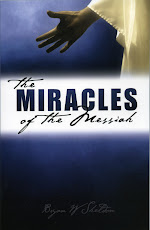Even before the foundation of the world God had been working to a plan. Essentially it was two fold. It was to produce a being that He could have fellowship with – that would learn from His wisdom and respond to His love. It would be an organism made up of those that already bore His imprint, that is, those that were made in His image and likeness, and so could be in perfect harmony with His own nature and would be able to be loved by Him, and love Him in return. In His wisdom and with His foresight He had already discounted the possibility of one individual member of His creation being able to fill this requirement. The disappointment, for disappointment it must have been, of the fall of Lucifer, suggests that this decision was the correct one, although He has given us no information to suggest that Lucifer or any of the angelic host were ever capable of responding to His love in any meaningful way. They were created as His servants to serve Him, although the nature of the Godhead demanded that even the service of such beings should be a willing service and not by compulsion. In consequence they were given the freedom of choice. No! The Omniscient One embarked on a course of action that would result in an organic, living entity that would be capable of fellowship with the Godhead by reason of many individual parts each bringing something unique and special to the relationship. And that by reason of great numbers and a wide array of gifts and abilities, harnessed together by a corporate delight in fellowship with God, they would collectively provide a beating heart of love that could respond to their divine Creator. His revealed aim then, is to have a great celestial ceremony amidst great rejoicing and in front of a great cloud of witnesses, to enter into a covenant relationship with the members of this foreknown and predestined group, who, although disparate in themselves are bound to each other by a common love of the Godhead. They will, when it takes place, be a united group, ‘all one in Christ Jesus’. The marriage ceremony between the Son of God and the Church is one of the last scenes provided for us in Scripture.
But our purpose here is to consider how the Abrahamic Covenant fits into this overall purpose of God. Here are some suggestions.
1. The whole scheme of things will rest on an incarnation. The wisdom of God created man in His image, and the purpose of God provided for the creation of the Church. Therefore it would seem essential that God should be created in man’s image, to enjoy this meaningful relationship. In other words, man was created in God’s image, so that God could be created in man’s image, so that man could be re-created in God’s image and in a unity named ‘Church’ be called to join the Son of God in marriage.
2. Since the Godhead exists in the eternal state, the incarnation would also be needed to accomplish a redemption that would result in mortals putting on immortality. For this union to work, the members of the ‘Church’ need to live for ever.
3. Abraham was chosen to father a nation that could accommodate the incarnation.
4. Identifying a particular nation at its beginning, that is, in the loins of one man, was necessary because this particular nation will have to provide the conditions that would allow the Son of God to live a holy life essentially without persecution or opposition. With Abraham God began with an almost blank canvas.
5. The nation would have to be trained in such a way that the redemptive plan of God could be accomplished seamlessly within its religious structure.
6. The nation would have to be brought into a relationship with the Godhead that would signify that God was prepared to be related to humankind. (Israel
7. Once redemption was accomplished the nation could provide a focal point for the offer of a relationship with God to be advertised. It would provide fertile ground for the gospel to take root and flourish.
8. Moreover, a nation that had been separated by its training and its relationship to the Lord, when scattered among the nations, as they surely would be, would be the best advertisement for the truth of monotheism. The God of Abraham and the God of Israel would be known in all lands.
So God selected a man, Abram, tested him and found him strong in faith, and suitable to be father of such a nation – more than that – he would be suitable to be the father of many nations, and the father of the faithful. This is the man he trained and entered into a covenant relationship with. So the line of the seed of the woman is going to come through Abraham, Isaac and Israel






No comments:
Post a Comment